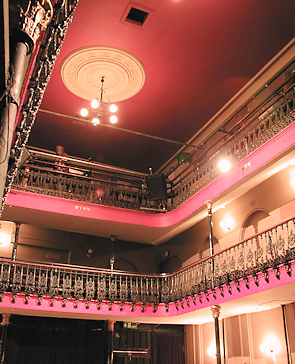|
|
 |
|
|
 |
A formerly working-class district in north-west Shoreditch, now
fashionable with members of London’s media and ‘dotcom’ industries. It is possible that hogs were once kept
here (hence Hogsden, a widely used alternative spelling in the past) but more likely that the place name derives from a farm
belonging to a man called Hōc. St Paul’s Cathedral owned the manor at the time of Domesday Book. There were attempts
in the 1680s to make Hoxton a sort of ‘North End’ to rival the West End, but the creation of Hoxton Square and
Charles Square failed to spark an inrush of wealthy homebuyers. Instead, Hoxton’s open spaces retained their market
gardens and gained hospitals, schools and public houses. A number of religious dissenters came to live here, most memorably
the Ancient Deists, who believed that they conversed with the dead. In The Birth of Modern London, Elizabeth McKellar
suggests that Hoxton’s unusual character encouraged ‘an alternative building tradition even on the very edge of
the commercial centre itself and ensured the continued survival of these buildings unmodernized throughout the 18th century’.
This piecemeal development encompassed a wide range, from mean tenements to mansion houses. Among the professional men who
settled here was James Parkinson of Hoxton Square. His Essay on Shaking Palsy, written in 1815, identified the disease
that now bears his name. Hoxton Fields had disappeared beneath Hoxton New Town by 1850. Hoxton was home to the renowned Britannia
Theatre, a music hall that Dickens compared with Milan’s La Scala. Built in 1858 it became one of Victorian London’s
greatest palaces of entertainment. Converted to a cinema in 1923, then demolished after wartime bomb damage, its name lives
on in the leisure centre at the corner of Shoreditch Park. Hoxton Hall, a saloon-style music hall built in 1863, survives
and is used for community arts and education purposes. Despite the post-war replacement of slum terraces with slum tower blocks
and the recent arrival of assorted creative types, Hoxton retains an identity and a spirit that has been lost in much of inner
London.
|
 |
|
|
|
 |

|
| Hoxton Hall: a visible artistic and creative presence in the community since 1863 |
The poet and playwright Ben Jonson killed fellow actor Gabriel Spencer
in a duel on Hoxton Fields in 1598, evading a death sentence because he could read from the Latin Bible. The proto-feminist
writer Mary Wollstonecraft was born in Hoxton, where her father was a silk weaver.
In 2002 David Beckham popularized a short haircut fronted with a
narrow tuft that was nicknamed a ‘Hoxton fin’.
|
 |
|
|
|
|
Postal
district: N1
Population: 10,698
Further reading: Christopher Miele, Hoxton Architecture and History
Over Five Centuries, Hackney Society, 1993
Bryan Magee, Clouds of Glory: A Childhood in Hoxton, Jonathan Cape,
2003
Text and selected images are reproduced with the permission
of Chambers but may differ from the published versions
All content © 2005–2010
|
|
|
 |

